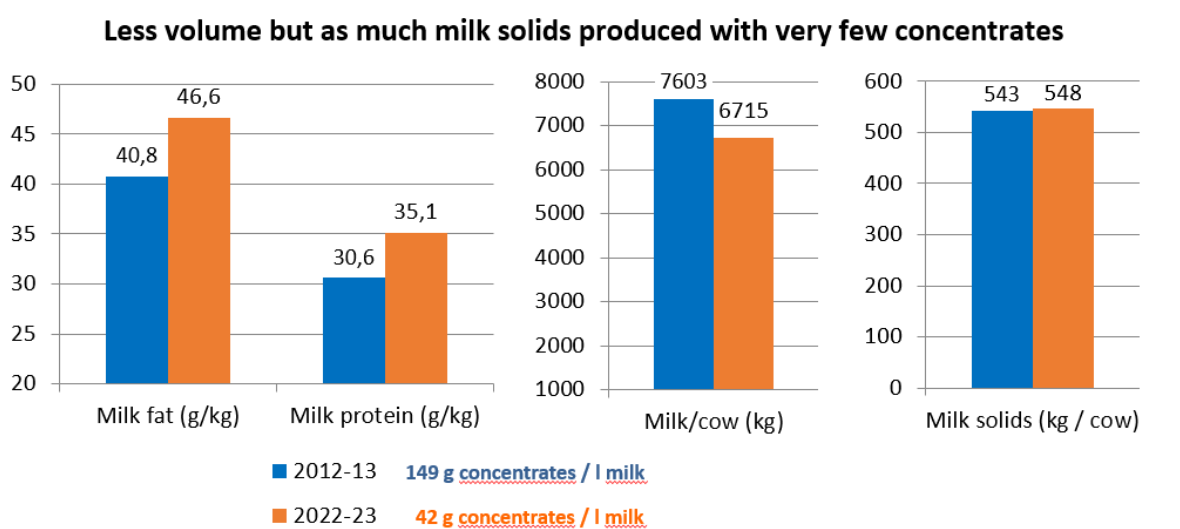OasYs
OasYs system experiment - a Research Infrastructure interacting with stakeholders
Research Infrastructure
OasYs is an agroecological dairy cattle system aiming to be adapted to climate change. Redesigned through a collaborative approach, it is carried out as a system experiment at the farm scale in an INRAE facility located in a French plain area already affected by summer droughts.
Background information
Aim
Enabling farmers to live from their dairy cattle system in a context of climate change, while saving water and fossil energy resources and contributing to a sustainable agriculture.
2012-2013: collaborative design of OasYs with various stakeholders
June 2013: implementation on an INRAE facility (Lusignan, Vienne, France)
Funding structure
INRAE, French Ministries of Research and of Agriculture, Fondation de France, European and national projects
Achievements
The nutritive value of 31 tree, 14 shrub and 7 liana species has been assessed.
Diversity of grazing resources enabled extension of grazing period.
The increase of fat and protein contents offset the decrease in milk production.
The system allowed 1.5 labor units to be remunerated at a rate equivalent to the income of two minimum wage earners.
Methods, stakeholder engagements and tools
OasYs is an innovative system redesigned through a collaborative approach with various stakeholders. It relies on an agroecological approach, based on the diversity of the system’s components and their functions, and aiming to adapt a low-input farm to climate change. It is experimented at the farm scale on an INRAE facility. The forage system (90 ha) produces the fodder necessary to feed the dairy cattle herd (72 milking cows, and replacement heifers) without irrigation and with limited use of mineral nitrogen fertiliser, whatever the climatic hazards. The forage resources are diversified (including fodder trees) and priority is given to their grazing. The livestock breeding strategy is in coherence with the forage system, with two calving periods in spring and autumn, the extension of lactation length to 16 months and the three-way crossing of dairy breeds (Holstein, Scandinavian Red, Jersey). The system is evaluated in terms of its production performance, as well as its environmental and socioeconomic performance. It is a place for exchange with various stakeholders.
Further information
Novak, S., Pelhate, E., Bourgoin, F., Chargelègue, F., Audebert, G., 2024. N, P, K balances for 6 grazed or cut plots in an agroecological dairy cattle system. 30th EGF General Meeting: “Why grasslands?, Leeuwarden (Pays-Bas), pp. 593-596. https://hal.science/hal-04595549v2/document
Novak, S., Guyard, R., Chargelègue, F., Audebert, G., Foray, S. 2022. Nitrogen use efficiency and carbon footprint of an agroecological dairy system based on diversified resources. In "29th EGF general meeting: Grassland at the heart of circular and sustainable food systems", Caen (France), 683-685. https://hal.science/hal-03689465v1/document
Novak, S., Didiot, C., Bourgoin, F., Guyard, R., Chargelègue, F., Audebert, G. 2022. Variability of multispecies grasslands production in a diversified agroecological dairy system. In "29th EGF general meeting: Grassland at the heart of circular and sustainable food systems", Caen (France), 451-453. https://hal.science/hal-03689443v1/document
Fodder trees on dairy farms. Link to Publication
Integrating agroforestry into an innovative mixed crop-dairy system. Link to publication
Mondière, A., Corson, M.S., Auberger, J., Durant, D., Foray, S., Glinec, J.-F., Green, P., Novak, S., Signoret, F., van der Werf, H.M.G., 2024. Trade-offs between higher productivity and lower environmental impacts for biodiversity-friendly and conventional cattle-oriented systems. Agricultural Systems 213, 103798. https://doi.org/10.1016/j.agsy.2023.103798
Activities
Forage diversification
Year round grazing
Browsed fodder trees
Integrated and innovative livestock breeding strategies
Multicriteria assessment













